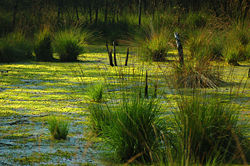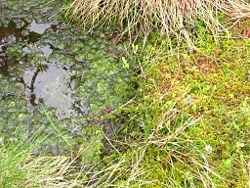
A bog is a freshwater wetland characterized by acidic peat deposits and by moisture provided by precipitation (rain and snow) rather than groundwater or interior drainage. The precipitation leaches nutrients from the soil, while acid is produced from the decomposing organic material (Finlayson and Moser 1991). The United Stated Environmental Protection Agency (EPA) considers the bog one of the four general categories of wetlands, the others being marshes, swamps, and fens (EPA 2004), although categorization of wetlands varies widely.
Importance
Overview
A bog is a type of wetland. A wetland is a transitional environment between permanently aquatic and terrestrial environments that shares characteristics of both environments and where water, which covers the soil or is near the surface for substantial parts of the year, is the key factor in determining the nature of the ecosystem and soil. Although wetlands have aspects similar to both wet and and dry environments, they cannot be classified unambiguously as either aquatic or terrestrial (Barbier et al. 1997).
A bog is a wetland type that accumulates acidic peat. Peat is the dark, fibrous accumulation of partially decomposed and disintegrated organic matter found in wet areas, usually residues of plants such as mosses, but also including sedges, trees, and other plant and even animal matter. It is generally light and spongy in consistency and dark brown or black in color. Many North American bogs are characterized by Sphagnum moss.

Bogs are not the only peat-forming wetland. For example, a fen is a freshwater, peat-forming wetland with chemically basic (which roughly means alkaline) ground water. This means that it contains a moderate or high proportion of hydroxyl ions (pH value greater than 7).
In bogs, moisture is provided essentially by precipitation, and for this reason bog waters are acidic and termed ombrotrophic (or cloud-fed), which accounts for their low plant nutrient status. Excess rainfall outflows, with dissolved tannins from the plant matter giving a distinctive tan color to bog waters.
In the United States, the four general categories of wetlands, according to the Environmental Protection Agency, are marshes, swamps, bogs, and fens. (EPA 2004) The term 'mires is sometimes used for a type of complex, wetland ecosystems that includes bogs and fens. Finlayson and Moser (1991) state that bogs are formed when rain and snow feed directly into an already high watertable, with nutrients leached from the soil and acid produced as organic material slowly decomposes. They distinguish bogs from fens by stating that fens are fed by ground water or by interior drainage into hollow rather than precipitation; they are higher in nutrients and lower in acidity, but can still produce peat.
The EPA notes that bogs often are formed in old glacial lakes and characterized by spongy peat deposits, evergreen trees and shrubs, and a floor covered by a thick carpet of sphagnum moss (EPA 2004).
Bogs are recognized as a significant habitat type by a number of governmental and conservation agencies. For example, the United Kingdom in its Biodiversity Action Plan establishes bog habitats as a priority for conservation. Bogs are challenging environments for plant life because they are low in nutrients and very acidic. Furthermore, the absorption of water by sphagnum moss reduces the amount of water available for plants. As a result of these unique conditions, many unique flora and fauna may be found. Carnivorous plants have adapted to the low nutrient conditions by using insects as a nutrient source. Some bog plants, such as Leatherleaf, have waxy leaves to help retain moisture. English bogs give a home to the boghopper beetle and a yellow fly called the hairy canary.
Distribution and extent
Bogs are widely distributed in cold, temperate climates, mostly in the northern hemisphere (Boreal). The world's largest wetlands are the bogs of the Western Siberian Lowlands in Russia, which cover more than 600,000 square kilometers. Sphagnum bogs historically were widespread in northern Europe, and Ireland was more than 15% bog. Achill Island off Ireland remains 87% bog.
There are extensive bogs in Canada and Alaska (labeled muskeg), Scotland, Denmark, Estonia (20% boglands), Finland (26%), northern Germany, the Netherlands, and Sweden. There are also bogs in the Falkland Islands.
Ombrotrophic wetlands (that is, bogs) are also found in the tropics, with notable areas documented in Kalimantan; these habitats are forested so would be better called swamps. Extensive bogs cover the northern areas of the U.S. states of Minnesota and Michigan, most notably on Isle Royale in Lake Superior. The pocosin of the southeastern United States is like a bog in that it is an acidic wetland but it has its own unusual combination of features. In certain areas such as Ireland and Scotland, coastal bogs are frequently intruded upon by low lying dunes called Machairs.
Importance
Industrial uses
A bog is a very early stage in the formation of coal deposits. In fact, bogs can catch fire and often sustain long-lasting smouldering blazes, producing smoke and carbon dioxide, thus causing health and environmental problems. After drying, peat is used as a fuel. More than 20% of home heat in Ireland comes from peat, and it is also used for fuel in Finland, Scotland, Germany, and Russia. Russia is the leading producer of peat for fuel at more than 90 million metric tons per year. Ireland's Bord na Móna (peat board) was one of the first companies to mechanically harvest peat.
The other major use of dried peat is as a soil amendment (sold as moss peat or sphagnum) to increase the soil's capacity to retain moisture and enrich the soil. It is also used as a mulch. Some distilleries, notably Laphroaig, use peat fires to smoke the barley used in making scotch whisky. More than 90% of the bogs in England have been destroyed.[1][2]
Other uses
Blueberries, cranberries, cloudberries, huckleberries, wild strawberries and lingonberries are harvested from the wild in bogs. Bog oak, wood that has been partially preserved by bogs, has been used in manufacture of furniture.
Sphagnum bogs are also used for sport, but this can be damaging. All-terrain vehicles are especially damaging to bogs. Bog snorkelling is popular in England and Wales.Llanwrtyd Wells, the smallest town in Wales, hosts the World Bog Snorkeling Championships. In this event, competitors with mask, snorkel, and scuba fins swim along a 60-meter trench cut through a peat bog.
Archaeology
In parts of Denmark, Germany, Ireland and the United Kingdom, peat bog conditions exist where the subsurface chemistry of moisture combined with an anaerobic environment, such that remarkable preservation of animal organisms can result.[3] Some bogs have preserved ancient oak logs useful in dendrochronology, and they have yielded extremely well-preserved bog bodies, with organs, skin, and hair intact, buried there thousands of years ago after apparent Germanic and Celtic human sacrifice. Excellent examples of such human specimens are Haraldskær Woman and Tollund Man in Denmark. In the Iron Age culture of Denmark, a discovery of several victims of ritual sacrifice by strangulation was recorded.[4] The corpses were thrown into peat bogs where they were discovered after 2000 years, perfectly preserved down to their facial expressions, although well-tanned by the acidic environment of the Danish bogs. The Germanic culture has similarities to the characteristics of the probably Celtic Lindow man found at Lindow Common and with the Frisian culture described in the story of St. Wulfram. In Ireland, at Ceide fields in County Mayo, a 5000 year old neolithic farming landscape complete with field walls and hut sites has been found preserved under a raised blanket bog.
ReferencesISBN links support NWE through referral fees
- Barbier, E. B., M. Mike Acreman, and D. Knowler. 1997. Economic Valuation of Wetlands: A Guide for Policy Makers and Planners. Gland, Switzerland: Ramsar Convention Bureau. ISBN 294007321X.
- Environmental Protection Agency. 2006a. What are wetlands?. U.S. Environmental Protection Agency. Retrieved May 3, 2008.
- Environmental Protection Agency. 2006b. Wetlands definitions. U.S. Environmental Protection Agency. Retrieved May 3, 2008.
- Environmental Protection Agency. 2004. Wetlands overview. U.S. Environmental Protection Agency EPA 843-F-04-011a (December 2004). Retrieved May 3, 2008.
- Finlayson, M., and M. Moser. 1991. What is peat? International Waterfowl and Wetlands Research Bureau (IWRB). Reprinted in Wetlands Australia 6: 7. Retrieved May 4, 2008.
http://www7.nationalgeographic.com/ngm/0709/bog-bodies/bog-bodies-photos.html?email=Focus24Aug07
External links
- Ballynahone Bog
- Black Spruce Bog Describes a forested bog type of North America
Credits
New World Encyclopedia writers and editors rewrote and completed the Wikipedia article in accordance with New World Encyclopedia standards. This article abides by terms of the Creative Commons CC-by-sa 3.0 License (CC-by-sa), which may be used and disseminated with proper attribution. Credit is due under the terms of this license that can reference both the New World Encyclopedia contributors and the selfless volunteer contributors of the Wikimedia Foundation. To cite this article click here for a list of acceptable citing formats.The history of earlier contributions by wikipedians is accessible to researchers here:
The history of this article since it was imported to New World Encyclopedia:
Note: Some restrictions may apply to use of individual images which are separately licensed.
- ↑ BBC NEWS | England | Cumbria | Insight into threatened peat bogs
- ↑ The RSPB: Policy
- ↑ C.M.Hogan, Haraldskaer Woman, Lumina Technologies Press, July, 2005
- ↑ P.V. Glob, The Bog People: Iron Age Man Preserved